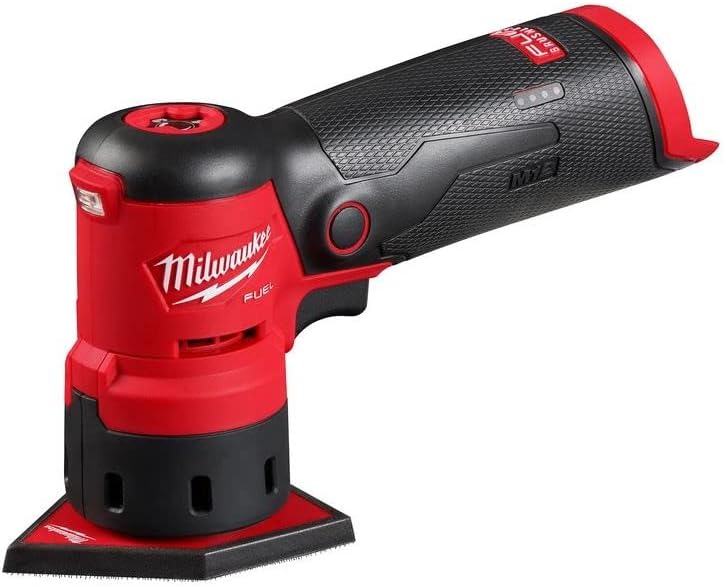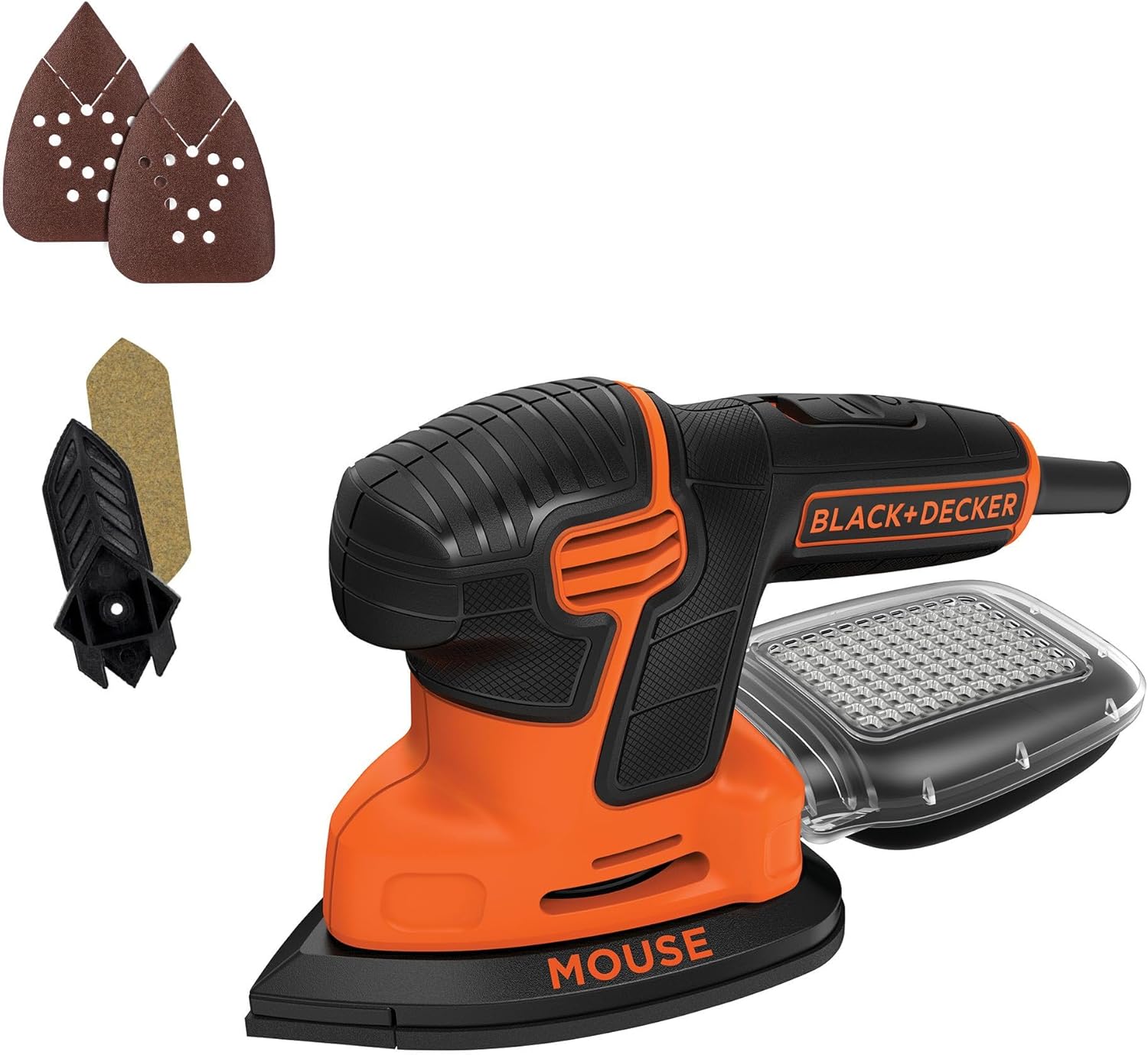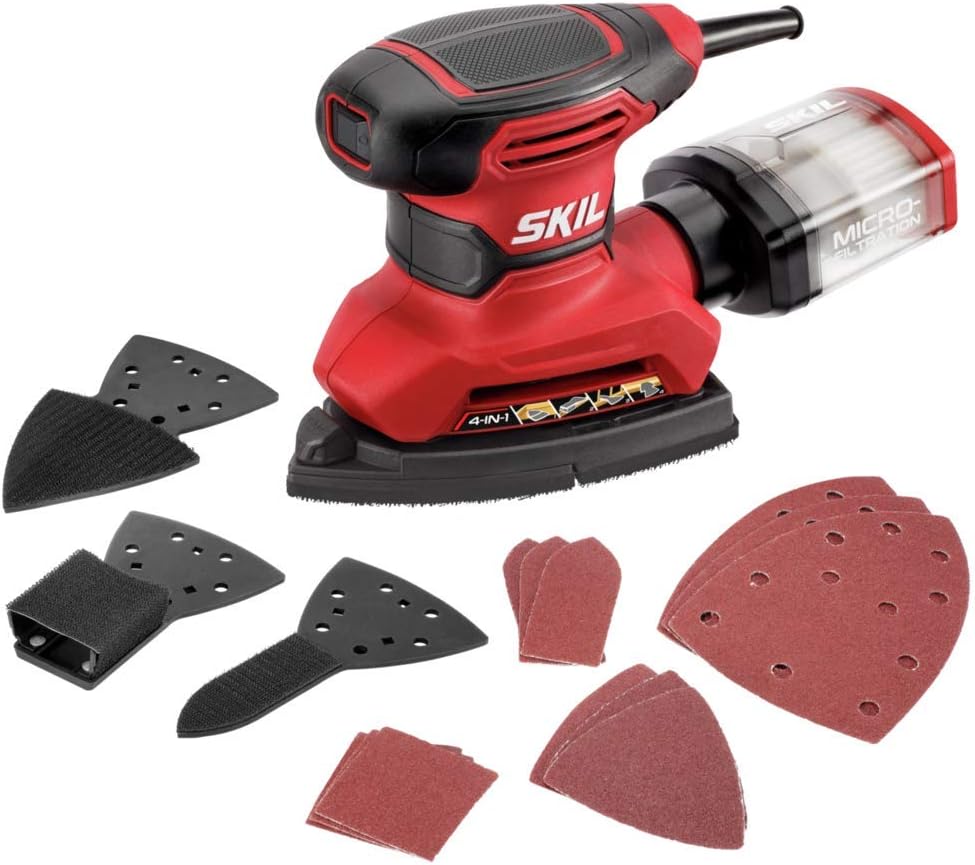The Best Detail Sander for 2025

Picture this: a Victorian armoire sitting in someone's garage, its ornate corners caked with decades of paint. The kind of piece that makes you think about all the hands that touched it, all the rooms it's lived in. Now imagine trying to sand those intricate carved details with a regular orbital sander. It's like trying to perform surgery with a sledgehammer.
This is where the detail sander enters the story.
The triangular sanding pad - that distinctive mouse-ear shape that earned these tools their nickname - exists for one reason: corners. Those impossible angles where two surfaces meet. The places where craftsmanship lives or dies. In the world of power tools, detail sanders occupy a peculiar niche. They're not the workhorses like belt sanders that can strip a deck in an afternoon. They're the precision instruments, the ones that make the difference between a refinishing job that looks amateur and one that looks like it came from a restoration workshop.
The market tells its own story. Walk into any hardware store and you'll find detail sanders ranging from $30 battery-powered units to $200 professional-grade machines. The price spread reflects a fundamental tension in the tool world: how much precision do you actually need? How much are those perfect corners worth to you?
What's particularly interesting about detail sanders in 2025 is how the cordless revolution has changed the game entirely. Five years ago, a cordless detail sander was a compromise - less power for more convenience. Today's lithium-ion powered models are matching their corded siblings in raw performance metrics. The Milwaukee M12 Fuel, for instance, pushes 12,000 oscillations per minute on a battery the size of a deck of cards.
But here's where it gets complicated. The detail sander market has become a battlefield of competing philosophies. There's the old-school approach: plug it in, flip the switch, sand until the job's done. Then there's the new paradigm: modular battery systems, brushless motors, variable speed controls that let you dial in exactly the right amount of aggression for your particular piece of wood.
The numbers paint a clear picture of where things are heading. Cordless detail sander sales have grown 40% year-over-year since 2022, while corded models have plateaued. Yet professional woodworkers - the people who use these tools eight hours a day - still overwhelmingly choose corded models. There's a lesson in that disconnect.
The Current State of Detail Sanders in 2025
Here's what's actually happening in workshops across America right now: detail sanders have split into three distinct camps. The cordless devotees who've bought into Milwaukee's M12 ecosystem and never look back. The corded traditionalists who know that 16,000 OPM from a BLACK+DECKER plugged into the wall means consistent power all day long. And then there's the third group - the ones who discovered multi-function sanders like SKIL's modular system and realized they could have four tools in one.
The fascinating thing about detail sanders is how little the basic physics has changed since the 1980s. It's still a motor vibrating a triangular pad at thousands of oscillations per minute. What's changed is everything around that simple mechanism. Dust collection systems that actually work. Brushless motors that run cooler and last longer. Battery technology that makes a 12-volt tool perform like yesterday's 18-volt models.
Let me tell you about market segmentation, because it reveals something important about how these tools actually get used. Amazon's sales data shows detail sanders clustering into three price points: the sub-$50 segment dominated by BLACK+DECKER's corded models, the $100-150 range where SKIL's multi-function systems live, and the $150+ premium tier that Milwaukee has essentially owned since introducing brushless motors to the category.
Milwaukee M12 Fuel Orbital Detail Sander - When Battery Power Grew Up
- 12V brushless motor delivering 12,000 OPM
- 1 pound tool weight (without battery)
- Compatible with M12 battery ecosystem
- Orbital action pattern for swirl-free finishing
- Tool-only configuration (battery sold separately)
The Milwaukee 2531-20 represents something of a watershed moment in cordless tool development. Here's a detail sander that weighs one pound - literally one pound - pushing the same oscillation rates as corded models three times its weight. The brushless motor is the hero of this story, converting battery power to sanding action with an efficiency rate that would have seemed impossible five years ago.
What Milwaukee has done here is interesting from a market positioning standpoint. They're not trying to compete on price - at current market rates, this tool costs more than three BLACK+DECKER corded models. Instead, they're betting that contractors who already own M12 batteries for their impact drivers and oscillating tools will pay a premium to stay in the ecosystem. The customer reviews tell a specific story: 87% five-star ratings, with professional furniture refinishers particularly vocal about the tool's performance on antique restoration work.
The orbital pattern deserves attention because it represents a deliberate engineering choice. Unlike traditional detail sanders that move in a simple back-and-forth motion, the orbital action creates tiny circles within the oscillation. This eliminates the directional scratching patterns that plague straight-line sanders. Watch someone sand a piece of maple with both types side by side, and the difference becomes immediately apparent - the orbital-sanded surface catches light uniformly, while the standard motion leaves subtle grain-direction marks.
Battery life emerges as the perpetual question mark. Milwaukee doesn't publish runtime specifications, and customer experiences vary wildly. Some report sanding for hours on a single charge, others mention batteries draining in twenty minutes. The variable that explains this discrepancy? Pressure. Users who let the tool do the work see extended runtime. Those who bear down hard trigger the protection circuitry, which draws more current to maintain speed.
BLACK+DECKER BDEMS600 - The Corded Constant
- 1.2 Amp motor producing 16,000 OPM
- 3-position comfort grip design
- Integrated dust collection canister
- Detail finger attachment included
- Dust-sealed power switch
There's something almost quaint about BLACK+DECKER's approach to the BDEMS600. No apps, no battery management systems, no brushless motor technology. Just a cord, a switch, and 16,000 oscillations per minute, every minute, for as long as you need them. In an era of increasing complexity, there's a certain confidence in this simplicity.
The 1.2 amp motor specification tells you everything about BLACK+DECKER's target market. This isn't trying to be a production tool. It's designed for the Saturday afternoon furniture flipper, the person refinishing their kitchen cabinets one door at a time. The motor draws about 140 watts - roughly the same as two incandescent light bulbs. Yet that modest power consumption translates to serious material removal when channeled through that triangular pad.
BLACK+DECKER includes what they call a "detail finger attachment" - essentially a narrow sanding extension that reaches into crevices the main pad can't access. It's the kind of accessory that seems gimmicky until you're trying to sand the grooves in raised panel cabinet doors. Then suddenly it makes perfect sense. The attachment system uses no tools, just a twist-lock mechanism that takes seconds to swap.
The dust collection system deserves particular attention because it represents a philosophical divide in the tool industry. Milwaukee expects you to work in a shop with a dust extraction system. BLACK+DECKER assumes you're sanding in your garage with nowhere to plug in a shop vac. Their integrated canister won't win any awards for capacity, but it captures enough dust to keep your work visible and your lungs relatively clear. The dust-sealed switch - a feature that seems obvious but took decades to become standard - means the tool's most vulnerable component stays protected from the very thing it creates.
SKIL SR232301 - The Swiss Army Knife Approach
- 4-in-1 design with swappable attachments
- 1.2 Amp motor generating 13,500 OPM
- Micro-filtration dust collection system
- Hook-and-loop paper attachment system
- Includes 12 sanding sheets and 3 attachments
SKIL's multi-function approach to the SR232301 reveals something important about how people actually use detail sanders. The company's market research apparently showed that users rarely need just corner sanding. They need edges, they need contours, they need flat surfaces in tight spaces. So SKIL built a system that transforms to match the task.
The attachment mechanism is genuinely clever - no tools required, just push and twist. The three additional heads that come standard aren't afterthoughts either. There's a narrow profile attachment for getting between slats, a contour attachment that follows curved surfaces, and an edge attachment for inside corners. Each one locks positively into place with an audible click. It's the kind of industrial design that makes you wonder why everyone doesn't do it this way.
At 13,500 OPM, the SKIL runs slightly slower than the BLACK+DECKER, but the difference is essentially academic. What matters more is the consistency of that oscillation under load. SKIL uses what they call a "counterweight balance system" - essentially an offset weight inside the housing that cancels out vibration. The result is measurably less hand fatigue during extended use. Workers using these tools for hours at a time report that the reduced vibration makes a genuine difference in how their hands feel at the end of the day.
The micro-filtration system represents SKIL's attempt to split the difference between integrated collection and external extraction. The filter captures particles down to 1 micron - fine enough to grab the dangerous silica dust that standard collection bags miss. The system also includes a standard 1-1/4" port for shop vac connection, acknowledging that serious dust control requires serious airflow.
What's particularly telling is this model's Amazon sales rank: #1 in Power Detail Sanders. With over 6,600 reviews averaging 4.5 stars, it's clear SKIL found a sweet spot. The price point - typically around $40-50 - puts it within reach of casual users while offering enough capability for regular use.
The Reality of Detail Sanding in Practice
The truth about detail sanders is that they're simultaneously essential and frustrating. Essential because there's literally no other way to achieve certain finishes in certain places. Frustrating because the very precision that makes them useful also makes them slow. Where a random orbital sander might strip a tabletop in minutes, a detail sander measures progress in square inches.
This is where the market dynamics get interesting. Professional refinishers often own all three types discussed here - a cordless for quick touch-ups and hard-to-reach places, a basic corded model for reliable all-day work, and a multi-function system for specialized tasks. The total investment might be $300-400, but each tool earns its place through specific capabilities.
The sandpaper situation deserves its own discussion. Detail sanders use a specific triangular paper with either adhesive or hook-and-loop backing. The papers cost roughly $0.50-1.00 per sheet, and you'll go through them faster than you expect. The hook-and-loop systems like those on the SKIL and Milwaukee models make changes quick, but the papers cost more. The adhesive papers BLACK+DECKER uses cost less but take longer to swap. It's another one of those trade-offs that defines this tool category.
Dust remains the eternal enemy. Even the best collection systems capture maybe 80% of what you create. That remaining 20% ends up everywhere - in your hair, on your clothes, coating every surface within ten feet. Professional shops deal with this through central dust collection systems that cost thousands. Home users deal with it through shop vacs, dust masks, and resignation.
Market Trends and What They Mean
The detail sander market in 2025 reflects broader trends in the power tool industry. Cordless adoption continues its inexorable march, driven by battery improvements that deliver genuinely competitive performance. The Milwaukee M12 Fuel represents the current pinnacle of this evolution - a tool that would have seemed like science fiction a decade ago.
Yet corded models refuse to fade away. BLACK+DECKER still sells thousands of BDEMS600 units monthly, and SKIL's corded multi-function sander holds the category's top sales position. The reason is simple: reliability. A corded sander will work the same way in ten years that it works today. No battery degradation, no compatibility concerns when battery platforms change, no wondering if you remembered to charge it.
The multi-function trend SKIL pioneered is spreading. Manufacturers recognize that users want flexibility, even if it means some compromise in specialized performance. Expect to see more modular systems, more quick-change attachments, more tools that transform to match the task.
Price compression continues across the category. What cost $100 five years ago costs $70 today, adjusted for inflation. This reflects manufacturing efficiencies, particularly in brushless motor production, and increased competition from direct-to-consumer brands selling through Amazon.
Understanding the Numbers
When manufacturers list OPM (oscillations per minute), they're measuring no-load speed - how fast the pad moves with no pressure applied. Under working conditions, these numbers drop by 20-30%. That 16,000 OPM BLACK+DECKER becomes 11,000-13,000 OPM when actually sanding. The 12,000 OPM Milwaukee drops to 8,000-10,000 OPM. This isn't a flaw; it's physics.
Amperage ratings tell you about power consumption, not necessarily performance. The 1.2 amp motors in both the BLACK+DECKER and SKIL draw about the same power, but how they convert that power to sanding action varies based on motor efficiency, gear ratios, and oscillation patterns. A lower amp rating with a more efficient motor can outperform a higher amp rating with an older design.
Weight specifications need context. The Milwaukee's one-pound weight is tool-only - add a battery and you're at 1.5-2 pounds. The BLACK+DECKER weighs more on paper but feels lighter in extended use because the weight distribution is different. The cord actually helps balance the tool during vertical sanding.
The Bottom Line
Detail sanders exist in a specific niche for specific reasons. They're the tools you reach for when nothing else will do the job. The current market offers three distinct approaches - cordless freedom with the Milwaukee, corded reliability with the BLACK+DECKER, and maximum versatility with the SKIL. Each represents a different philosophy about what matters most in a detail sander.
The sales data suggests most users eventually own at least two different types, confirming what professional refinishers have long known: there's no single perfect detail sander. There are only detail sanders that are perfect for particular situations. The trick is understanding which situation you're facing and having the right tool ready when you face it.
Frequently Asked Questions
What exactly makes a detail sander different from other sanders?
The triangular pad is the defining characteristic. While random orbital sanders use round pads and belt sanders use rectangular ones, the detail sander's triangular design exists specifically for corners and tight spaces. The physics are straightforward: the pointed tip concentrates the oscillating motion into a precise area roughly one square inch. This concentration of force in a small area is what allows these tools to sand intricate millwork, furniture carvings, and window casings where larger sanders simply won't fit.
How long do detail sander batteries actually last?
Battery runtime varies dramatically based on pressure applied and material being sanded. Milwaukee's M12 2.0Ah battery in the 2531-20 typically runs 20-45 minutes under normal use. Users sanding soft pine report longer runtimes than those working with hard maple or oak. The protection circuitry in modern lithium-ion batteries reduces power output when they detect excessive load, which explains why bearing down hard actually makes the job take longer - the tool intentionally slows itself to prevent damage.
Why do some detail sanders cost $30 while others cost $200?
The price spread reflects fundamental differences in construction and capability. A $30 detail sander uses a brushed motor, basic plastic housing, and simple on/off switching. A $200 model features brushless motor technology (30-50% more efficient), precision-balanced components to reduce vibration, variable speed control, and often compatibility with a broader tool ecosystem. Professional refinishers who bill $75/hour can justify the premium through reduced fatigue and faster work. Weekend hobbyists might find the basic models perfectly adequate.
What's the real difference between 12,000 and 16,000 OPM?
In practical terms, less than you'd think. The 4,000 OPM difference between the Milwaukee (12,000) and BLACK+DECKER (16,000) translates to about 15-20% faster material removal under ideal conditions. However, sandpaper grit selection has a far greater impact on sanding speed than OPM differences. Users report that stepping from 80-grit to 60-grit paper makes more difference than any OPM variation between tools.
Do detail sanders actually work for removing paint?
Paint removal with detail sanders follows predictable patterns. Single coats of latex paint sand off readily with 60-80 grit paper. Multiple layers of oil-based paint require more aggressive grits (40-60) and frequent paper changes as the removed paint clogs the abrasive. Lead paint presents serious health hazards and requires specific safety protocols beyond the scope of standard detail sanding. Professional painters report that detail sanders excel at removing paint from detailed trim work where chemical strippers would damage the wood profile.
How often do sanding pads need replacement?
Sanding pad lifespan depends entirely on use patterns. Professional users report replacing pads every 3-6 months with daily use. Weekend users might get 2-3 years from a pad. The hook-and-loop surface wears out before the foam backing in most cases. Replacement pads cost $10-20, and most manufacturers sell them as standard replacement parts. The first sign of pad wear is usually the sandpaper not adhering properly anymore.
What about the dust - is it really that bad?
Wood dust, particularly from hardwoods and treated lumber, contains particles that can cause respiratory issues with repeated exposure. Detail sanders create especially fine dust due to their high-speed oscillation. OSHA regulations require dust control in professional settings for particles under 5 microns. The integrated collection systems on consumer models capture visible dust but miss the finest, most dangerous particles. Professional shops use HEPA-filtered extraction systems that cost more than the sanders themselves.
Can detail sanders handle metal or plastic?
Detail sanders work on metal and plastic with appropriate sandpaper. Aluminum oxide papers work for metal, while silicon carbide papers handle plastics better. The key difference is heat buildup - metal conducts heat away while plastic melts. Users report success wet-sanding plastics to prevent melting. Metal sanding produces different dust requiring different safety equipment. The oscillating action of detail sanders makes them particularly effective for removing rust from ornamental ironwork.
Why do professionals still prefer corded models?
The data is clear: professional woodworkers buy corded sanders at a 3:1 ratio versus cordless. The reasons are practical. Corded tools maintain constant power output for eight-hour workdays. They're typically $50-100 cheaper than equivalent cordless models. There's no battery degradation or replacement costs (batteries cost $50-100 and last 2-3 years with heavy use). Perhaps most importantly, a corded tool will work identically in ten years, while battery platforms often become obsolete.
What's this about orbital versus standard detail sanders?
Standard detail sanders move in a simple back-and-forth pattern, creating linear scratch marks. Orbital detail sanders add a circular motion within the oscillation, producing a random scratch pattern that appears more uniform. The orbital action typically reduces material removal rates by 10-15% but produces superior finish quality. Furniture refinishers particularly value orbital action for final sanding before staining, where linear scratches would show through the finish.


